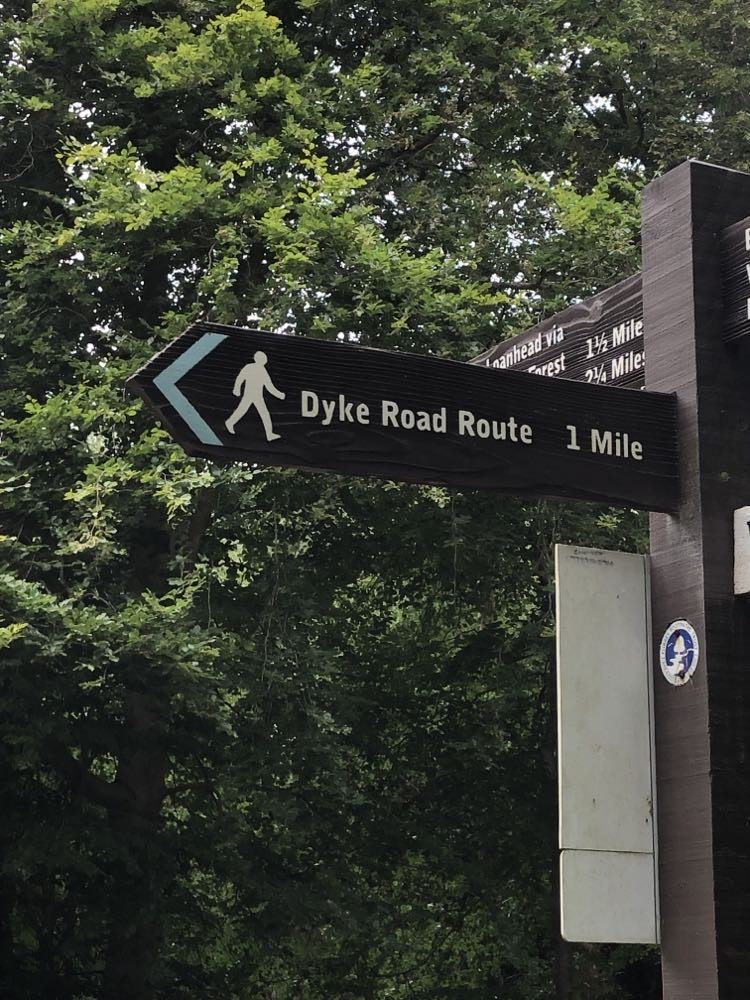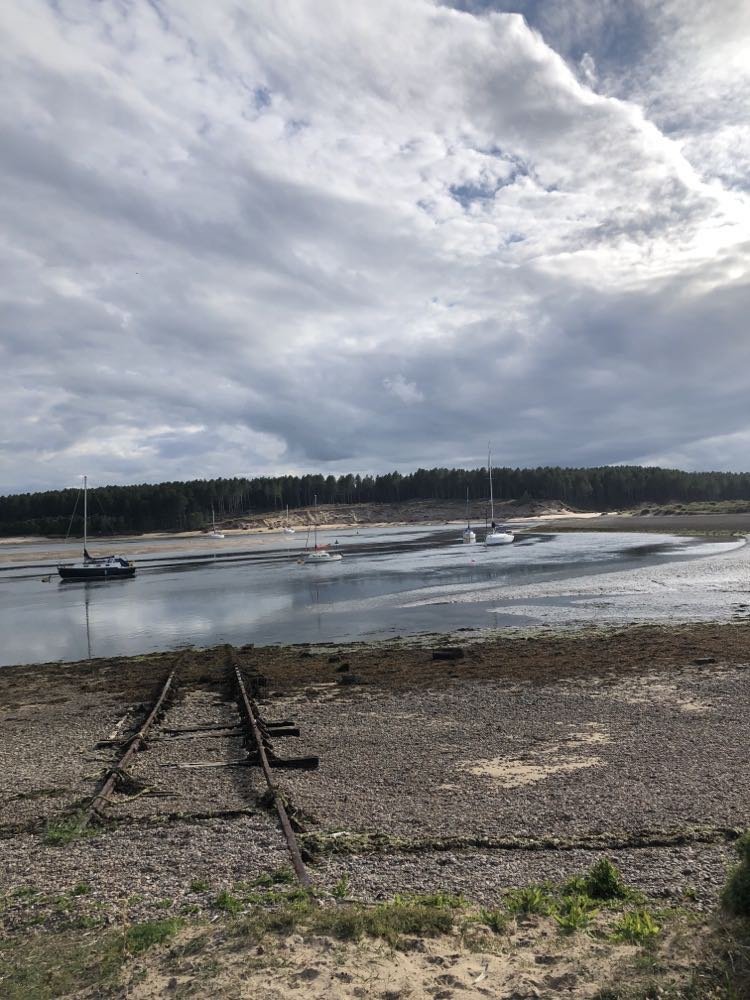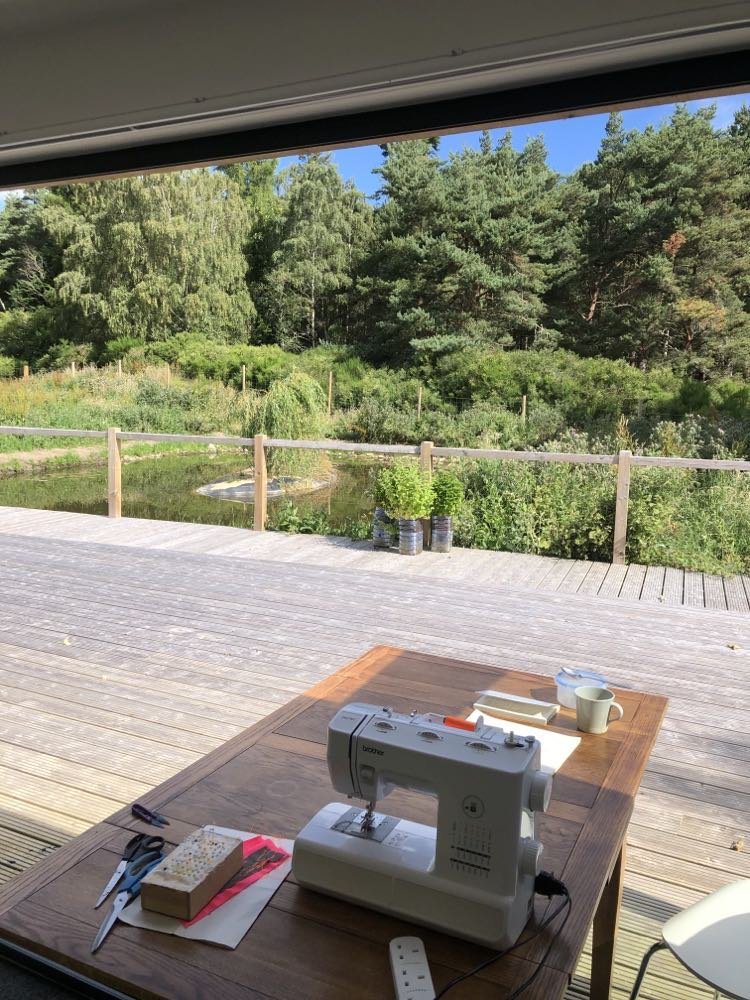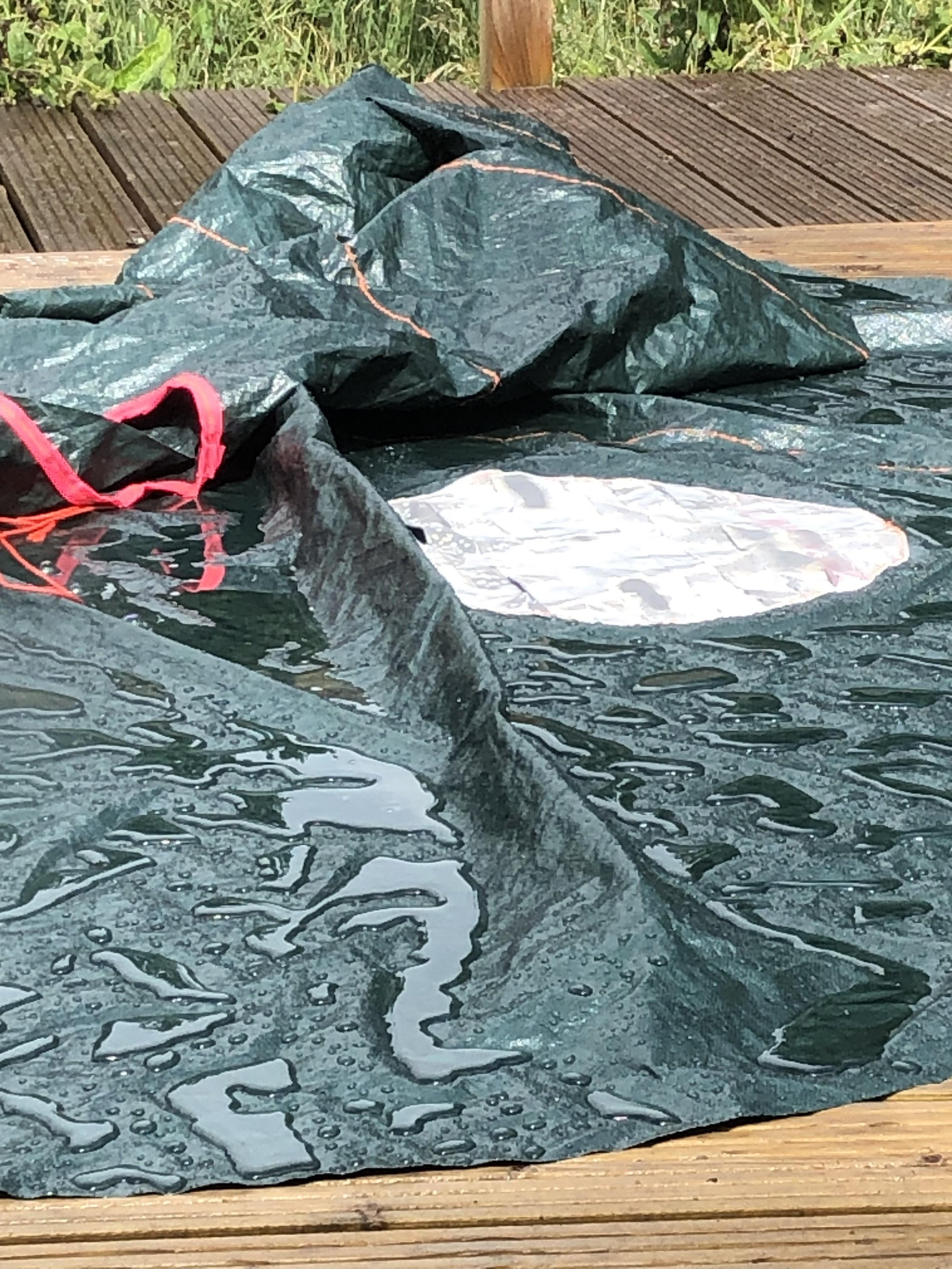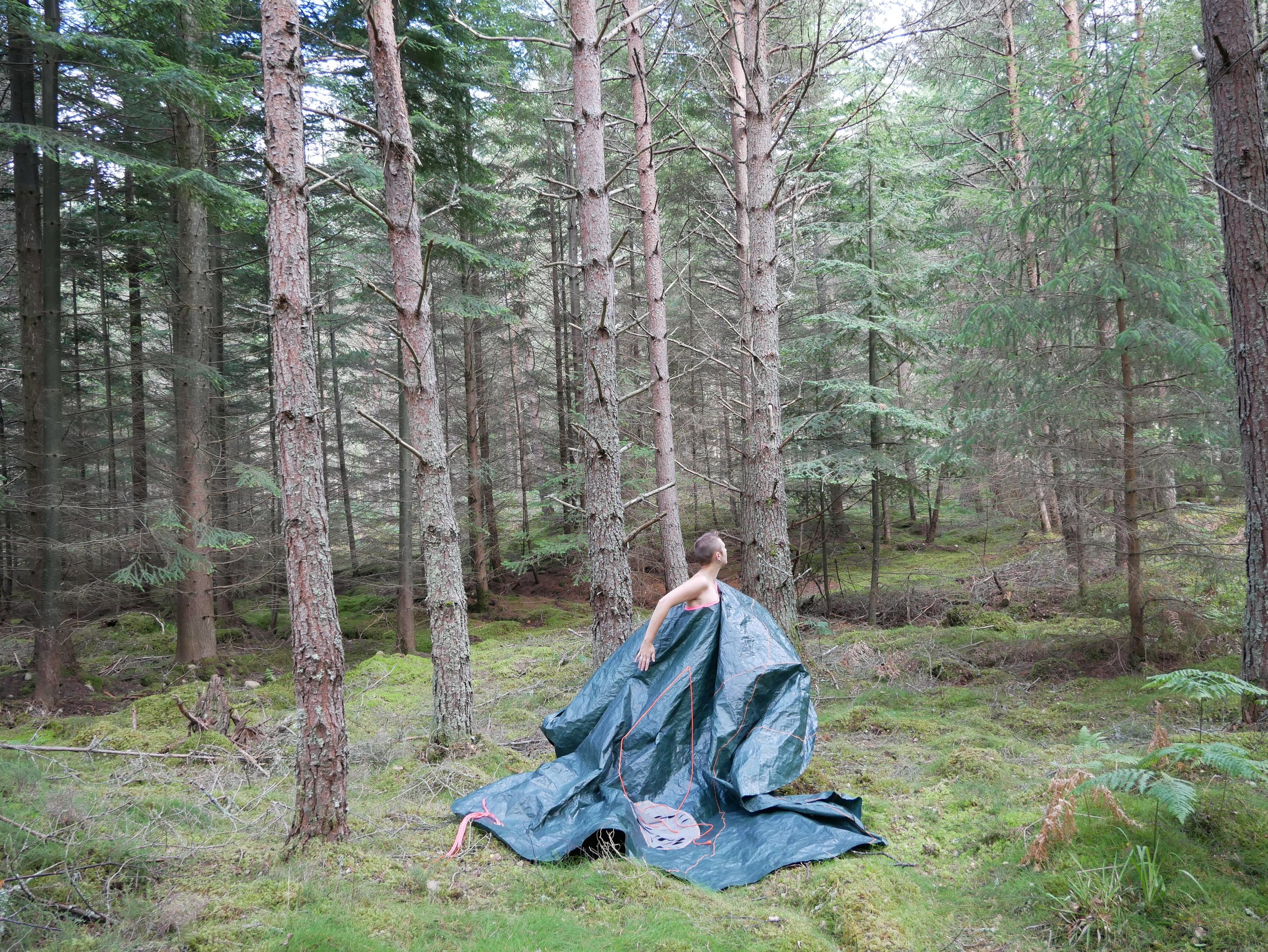Highlands residency blog:
WEEK ONE
The path in the wilderness, winding before you or not yet trodden, is an invitation to come out in order to come in; to a surer knowing of place, to make place. John of the Mountains (Scottish-born American ecological writer and environmental philosopher John Muir) once said, in reference to the transformative experience of hiking, that 'going out...was really going in' (Muir). I feel this coming to know through doing, embodying knowledge, this learning of the self through travel, is synonymous with the process of 'coming out' as queer. Such emotional understanding of self only comes with processing, with an engagement in the journey. We follow clues and passages, looking for or turning towards self; we find a tree or a person or a land-mark that affects us in a unique way, and then as time passes, 'the universe merely refers you onwards' (Shepherd, 2019 xxiv) to the next revealing clue; leading you to where you do not know. But you'll know you. You'll know you are complex and weathered and striding towards... known. Noun. Necessary shifts. Supple, subtle, somatic, sensory empathy.
Just 'as the earth must see itself' (Shepherd, 2019 xxii), we bear witness to our own changes, in the quiet vastness of the wild landscape.
'The tonic of wilderness' (Thoreau, 2019) offers us somatic knowing, whenever we engage. The lesbian closes her eyes and sees herself, in a soft, shifting landscape. Transverse; transfer weight, translate through kinesthetic learning, embodied listening... to foot firmly kissing earth, ribs filled with wind, arms blown and lifted, lips and nostrils open and wet and coated in pollen.
Vibrations across
water’s surface,
hairy skin,
porous leaf.
All a sign of travel. Of becoming.
She strides on to quench a thirst. To come to know, and to let go.
Black lesbian photographer Ingrid Pollard trespassed in Cumbria and made racialised and gendered violence visible through testimony: in her artwork and in rural landscapes, she says ‘I was there’. (Park, 214)
Place-making is about shifting relationship to space through activity that accelerates self-knowing in the given context; familiarity with surroundings, using all senses, feeling into space, transforming into place. Place-making is saying ‘I am here’.
We do not live in a world that celebrates slowness, presence, skills associated with domesticity: hosting, witnessing, nurturing. But these skills are radical and are queer, unbound from linear notions of productivity or progress. This practice of self-knowing in the context of world-knowing, of place-knowing is anti-binary. Is feminist.
I am one week into a month of research but have been working with such familiar subjects, it almost already feels like a retrospective on coming out. Thinking back to walking projects whilst walking here; Cornwall, Devon, the Peak District, walkshops in Nottingham and in Glasgow. And now the highlands, I tread new ground and reflect on my self-knowing in a very raw and confronting way, as I move through spaces, that quickly become places. Tasks I set myself are old practice but feel brand new here; making scores, drawing maps, sewing costumes that become shelters that become placards that become scores.
It has been the hottest week on record and I’ve been reading Funny Weather: Art in An Emergency by Olivia Laing (2021), who is ‘amazed’ that we are still capable of gestures of love. We are amazing in that way, to be loving and generous despite the multitude of colliding catastrophes we grapple with today. To show creative compassion is radical but also rudimental; how could we be here without love? How could we be queer without love?
And for me now and moving forward into these coming weeks of research, ‘circumambulation has replaced summit-fever, plateau has substituted for peak’ (MacFarlane & Shepherd, 2019) - I feel flat and calm and am circling… anarcha-feminism and queerness drive my research into occupying shared territories and cyclical introspective learning.
9/7/23
Bibliography
Laing, O. (2021) Funny weather: Art in an emergency. W. W. Norton Company.
MacFarlane, R. and Shepherd, N. (2019) in Foreword: The living mountain: A celebration of the Cairngorm Mountains of Scotland. Edinburgh: Canongate, pp. xiv.
Muir, J. (no date) John of the mountains quotes by John Muir, Goodreads. Available at: https://www.goodreads.com/work/quotes/6927446-john-of-the-mountains-the-unpublished-journals-of-john-muir (Accessed: 07 July 2023).
Park, G. (no date) The Pavilion Women’s Photography Center 1983 1993. Available at: https://etheses.whiterose.ac.uk/22160/1/Park_G_FAHACS_PhD_2018.pdf (Accessed: 10 July 2023). pp 214.
Shepherd, N. (2019) in The living mountain: A celebration of the Cairngorm Mountains of Scotland. Edinburgh: Canongate, p. xxiv.
Thoreau, H.D. (2019) Henry David Thoreau - Walden or life in the woods bilder von Heike Ellermann zu zitaten aus ‘walden: Or, life in the Woods’, 1854 von Henry David Thoreau (1817-1862). Oldenburg: Eigenverlag.
WEEK TWO
Last week I started the residency feeling quite solemn and sincere. This week I’ve found silliness and as I make space place, I am becoming more confident and comfortable (and embracing clumsiness) in my surroundings. I’ve written less and produced more practical work and am enjoying being able to share some of that creativity with peers; staff and students in Altyre and new friends made in Forres and Findhorn.
I had a walk with Shona MacPhearson, who leads trekking for wellbeing journeys and we shared ideas around coming out/coming to know, through walking. She’s given me some ambitious mountain routes to try to tackle too.
I’ve been moving with more abundance - dancing on the beach and dancing in the woods. I’ve been walking for miles and cycling when I want to feel the wind. During these embodied experiences I have thought often of the common idea in somatics that when we touch someone/thing, we are touched back by that person/thing; that touch runs two-ways and is 50-50. In psychotherapy this is problematic for patients with trauma linked to non-consensual touch, but how healing to think of this idea in relation to ‘the elements’.
To come home in the evening with tight, tingling skin from wind and grass and sand and branches and midges and rain and mosquitoes smacking into my body all day, is a privilege. To taste sea salt thick enough to brush off skin after being dried in intense (brief) penetrating sunshine, by the shore.
It’s not sexual as such, but I am learning to lean into and to trust being alone in the wild - and that independence, alongside my thinking on sexuality/’coming out’, has a sensuality
consent to
feel through every cell, deep inhale and many smells,
bare skin, tick risks, relax and rest in open field,
liberate
limb
hitch-hiking, losing phone battery
signal
following internal compas
sun or familiar road or smell
The dyke that hikes knows her body well.
‘A mountain has an inside’
(Shepherd 2019. p 16)
I have created a costume that is a tent, that is mountainous in shape and that has an inside. It is a shelter and a dress and a mat and a landscape in itself. It is versatile and playful and dances in the wind and across my body. And I across it. It is made from flotsam from other projects; materials with which I am familiar.
In it I am at home.
It is already weathered after a week of being out and about with me. I have stitched patterns across the thick tarp; scores and maps for navigating landscapes (of body, of mountain, of itself).
The movement I have been generating is in relation to this large weathered plastic sheet. It’s a container. With rules* for traversing landscape. Stitched into the surface, there are now scores for
TRAVELING
OPENING
ENTERING
CIRCLING
COMING OUT
This week the choreography has often been gestural
A twitching vibrating motion like a shaking off. Or a mimicking of wind, sunlight or rain.
Or a seeking gesture - searching for meaning through hands that are eyes. Searching for a path with fingers that are brain. And through the mind that is in the feet, I push hard earth to carve path.
Gestures finding Gestalt** that communicate inwards and out and circle through. (and when that cycle breaks the gesture of communication is lost within or expelled outside and intention is gone. This is improvisation.)
*open invitation to break rules
**German psychology term defined as ‘unified whole’ for gaining meaningful perceptions from stimuli through mind and body as one perceptive entity.
‘The way the body speaks to itself from the outside to its inside and from the inside to its outside is through its hands as much as it is through speech or facial expressions. The hands are action organs; they know these two worlds kinesthetically and tactically. The hands are extensions of the body wall and the cortex that communicate to each other and influence the behavior of each other.’ (Keleman 2014)
‘Place and mind may interpenetrate till the nature of both is altered’
(Shepherd 2019. p 8)
14/7/23
Bibliography
Keleman, S. (2014). Touching and being touched: The hand as a brain. Available at: https://www.thescienceofpsychotherapy.com/touching-and-being-touched-the-hand-as-a-brain
Shepherd, N. (2019) in The living mountain: A celebration of the Cairngorm Mountains of Scotland. Edinburgh: Canongate
WEEK THREE
‘Walk the flesh transparent’
(Shepherd 2019 p xxxi)
‘I remember swimming naked like building a new empire
Walking until the end of a desert island
Flock’s storks flying like a far away family
Farewells following lost sights
Smells of foreign’s flowers
Deep blue deep red against
Our soul’s transparency
…you walk straight to the window
Trusting every transparency’
(Cornu 2023)
As I document my work, I have an opposing desire to think of myself as transparent. I took this with me when I ‘danced the flesh transparent’ at Pride parties in Glasgow last weekend and shall at Highland Pride in Inverness this coming weekend.
I want to be
seen fully
or not seen at all
Having crawled inside my den half naked, I am about to come out.
Rain hits plastic and I notice the score I stitched across the surface shift under the weight of wind and water. The map only represents what I want it to, it is open to my interpretation. I am open to it.
Trusting every transparency this week I notice my self-consciousness on camera. I look at the lens and look away. I perform to the trees, to the insects, to the score. It feels authentic to ignore the camera but in itself that act is in-authentic; to set up the tripod in a silent field, step away from it and into the frame (though I have danced off frame for a lot of this week, unintentionally!). To be seen but only retrospectively and for now only by myself, knowing this image could be disseminated.
What am I trying to capture? A trust in transparency. A relationship with wilderness, queerness, climate, body, truth. An addressing of my unease here, in text, and in motion.
‘Can I just grieve for a second?’
Kathy Jetnil-Kijiner (Solnit & Lutunatabua, 2023 p 119)
I’m only narrowly avoiding despair at the climate catastrophe accelerating so rapidly during this residency. Half the world is burning up it seems. It’s cool here, sometimes cold. And wet too. Imagine, we’re in the small part of the world where we might need a jumper in July. With cynicism I am reading Not Too Late (Solnit & Lutunatabua, 2023) and clinging to reasons to keep generating.
On keeping hope ‘practical and grounded’, Jetnil-Kijiner (Solnit & Lutunatabua, 2023 p 123) says ‘I’m just going to solve this next task, which contributes to this overall plan, which will hopefully keep us in place.’
A way to choreograph/a way to live with grief - small steps and a big picture.
My choreographic process is much like this; solving a task (set by myself), which contributes to an overall plan… The movement repertoire I’ve worked on during the residency has been responsive to my internal and external environment, and to what I’ve been reading and writing. It’s been about listening to movement inside and feeling for movements around me and replicating or reacting to those in gesture. And of course the tarpaulin has tasks set across it; offerings for movement through space.
I have described my process in Doric (Mid Northern Scots dialect), referencing vocabulary Shepherd used throughout The Living Mountain:
Thrums (scraps of thread)
Thirled (bound, tied)
Swacker (more supple),
Yon (that)
Jaud ((common) woman)
Wrocht (worked, labored)
To lippen to (to trust)
Rickle (a structure put loosely together, a loose heap),
Chau’mer (chamber, bothy)
Dirl (rings, vibrates),
Whiles (at the same time)
Ootlin (outsider, outcast)
Flist (storm of temper)
Rary (goes about noisily)
Spangin (walking vigorously)
Swage (loosens, eases)
.
Fash yersel (put yourself in trouble)
Clorted (covered with mud),
dubbit (covered with mud)
Ficher (fiddle, fidget)
Fan (when)
Sotter (untidy dress)
Reeshle (rustle)
Drookit (soaked, drowned)
Birse (force press upwards, temper roused)
Rax (stretch)
Pech (sigh)
Oxter (arm-pit, to put the arm round)
Naive (fist)
Or (before)
Keeking (peeking)
Fa (who)?
Jaud-loon, inen hotterel, kittled, hirple
((common) woman-lad in among a swarm, tickled, limp)
Fat (what)?
Whammlin’, sic mannie sic horsie
(jogging, like master, like man)
Faur (where)?
Ben the hoose, ben the blaud
(inside, further into the house, further into the soil)
20/7/23
Bibliography
Cornu, C. (2023) ‘stranded (heartbeats)’, Dyke Love, Dykehouse Press, p. 14.
Shepherd, N. (2019) in The living mountain: A celebration of the Cairngorm Mountains of Scotland. Edinburgh: Canongate, p. Xxxi
Solnit, R. and Lutunatabua, T.Y. (2023) Not too late: Changing the climate story from despair to possibility. Chicago, IL: Haymarket Books.
WEEK FOUR
Editing film and photographs taken in the highlands this week, following rich conversations with staff, students and visitors, has felt like a really clear, conclusive process. Editing film is also so choreographic; treating each frame like a dance phrase, working with or against narrative. I love to use a beat, to think about the viewer’s relationship to rhythm - I’ve made a heartbeat-sounding thud of footsteps, recorded whilst walking on Altyre Estate. The pace is steady but constant.
Ingrid Pollard (2022, p 130):
‘I remember
dark chambers light filled rooms
those who observe the moving spectacle
in the darkened camera obscura
note the flickering images
the branches in the wind
shifting in and out of focus
the glimmering dance
of moving water
look this way
don’t smile
turn toward the light
close your eyes’
However conclusive I’ve tried to be in my creative work this week, I’ve also opened up new ideas during my visits to Glasgow Women’s Library, where they have a Walking Library archive and some of the artwork presented there by Ingrid Pollard archived too. Rummaging and connecting my practical research to the work of so many others, and finding commonalities, has been so rewarding. In this last blog install I quote several walker-writer-dancers I discovered this week.
I take advice from Wild Philosophy (2018):
‘The problem is the solution
Use the edges and the marginal
Slow and small solutions’
This got me thinking more about boundaries:
I trespass the somatic space beyond my comfort zone. I feel into the thin plastic sheet that separates me from earth. I collapse the boundary between myself and mountain, by being in both.
Push into earth with bare skin.
Open mouth: participate in wind.
I edit the film with kinesthetic empathy for a unique time and experience up in the highlands:
From Approaching Choreography: A Proposal for Engagement (2014):
‘Bring focus to the side lines
Margins are not marginal
Allow for the presence of absence’
‘Reflecting is a way in to learning, understanding and generating material.
Bring all the senses to the work.
Take yourself to the site rather than take elements of the site with you.
Reflecting is not copying. It’s about observing and interpreting.
Dancing is visceral as well as visual.
Water leaks in transport.
It grounds the work.
Search out points of contact.
Consider the quality of meetings and meeting places.
Look out for passing places.
Flow can gain interest from an interruption or an obstacle.
Allow ourselves to be acted upon.
Allow other time frames
to determine
the duration
of phrases
And performances.
Allow pathways to be guided by what is already there.
Wandering off the path might be the best path to take.
Crossing pathways is an event.
Pathways through
A branch, an insect, another dancer.
Good forage is rarely to be found on the path.
It requires sensitive negotiations.’
The weathered, sculptural tarp is a landscape on a landscape.The design is playful, it’s malleable and can shift between camouflage and (high-)visibility. It is an offering for choreographic structure. I am within and without it. It has an inside. And inside it is me. It has a surface. And upon that surface is me.
And I am a landscape too. Multiple! Internal and external: rolling hills, rivers, valleys and peaks and colliding tectonic plates. Across my surface and beneath my surface. The mountain has an inside just like me.
‘The human figure is a constant presence in Ingrid Pollard’s work, animating the landscape and shaping it’s contours, leaving residues of it’s passage in its hills and valleys. Like the recurring cycles of the sun and moon, human beings move through space and time repeatedly, tracing their steps, the same but different’. Pollard (2022, p 152)
I have used:
Embodiment as a mode of empathy
Costume as a mode of transport
Camera as a mode of live archiving
Editing as a mode of refining
Etc etc
land mark
‘a mark showing a boundary of a piece of land
a turing point
a watershed
the position of a prominent or well-know object in a particular landscape
an event marking a unique or important historical change of course or one on which important developments depend
an anatomical structure used as a point of origin in a locating anatomical structures’
(Wilson, 2015)
At the end of The Living Mountain is an afterword by Jeanette Winterson. She writes of finding roots inside oneself and of finding freedom to roam inside too. She writes of searching for/finding her mystical ‘shining centre’ (Shepherd 2019, p 112). Winterson came out as a lesbian at 16 years old; she searched inside and came out, or came out in order to look inside.
I finish this project with many open lines of enquiry and a deepened understanding of the area of Moray in the Highlands and with new tools for my place-making practice. I hope to go back up there soon…
In Haggs in High Places, Harrington (2015) describes genius loci (the protective spirit of a place - from classical Roman religion) as having ‘a power
that draws us in their direction at particular times in our lives.’
28/7/23
Bibliography
Approaching Choreography: A Proposal for Engagement (2014).
Harmon, K.A. (2004) You are here: Personal geographies and other maps of the imagination. New York, NY: Princeton Architectural Press.
Harrington, L. (2015) Haggs And High Places. Newcastle: Durham Book Festival.
Heddon, D. and Turner, C. (2012) ‘Walking women: Shifting the tales and scales of Mobility’, Contemporary Theatre Review, 22(2), pp. 224–236. doi:10.1080/10486801.2012.666741.
Pollard, I. et al. (2022) Ingrid Pollard: Carbon slowly turning. London: Philip Wilson Publishers/Bloomsbury Publishing Plc.
Shepherd, N. (2019) in The living mountain: A celebration of the Cairngorm Mountains of Scotland. Edinburgh: Canongate
Wild Philisophy: Raving, Running, Reading (2018). Chapter Arts, LADA .
Wilson, L.A. (2015) Warnscale: A land mark walk reflecting on in/fertility and childlessness. Leeds: Louise Ann Wilson Company.

